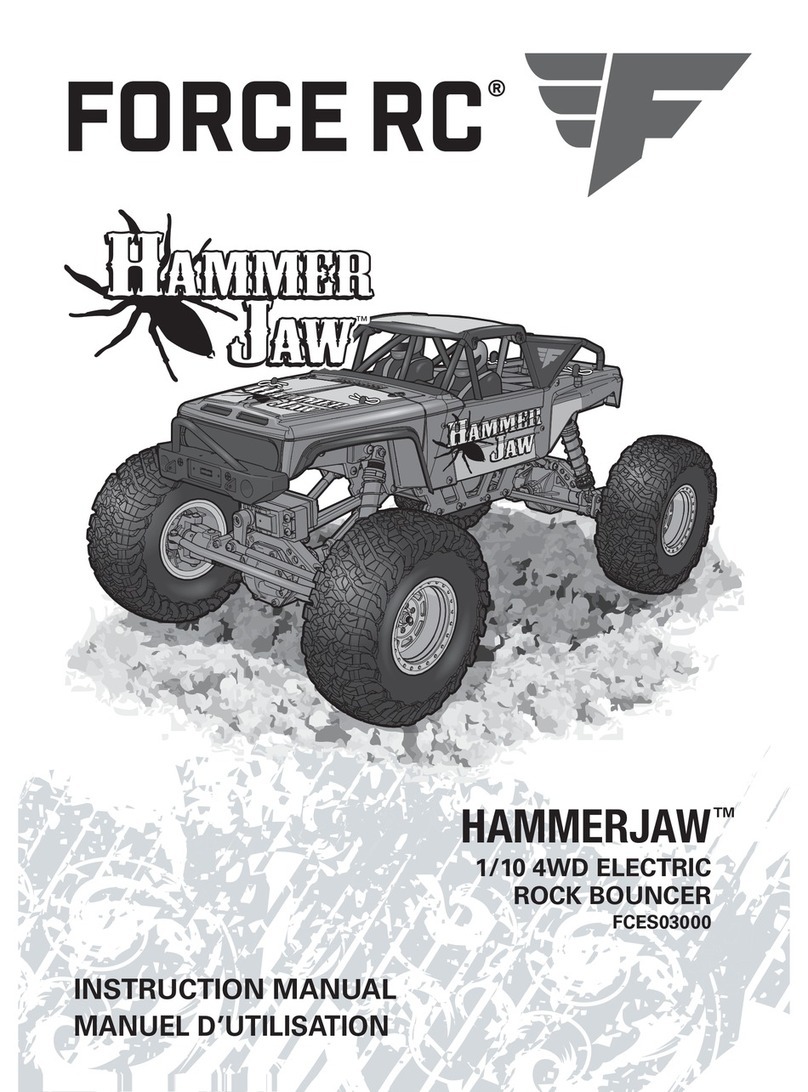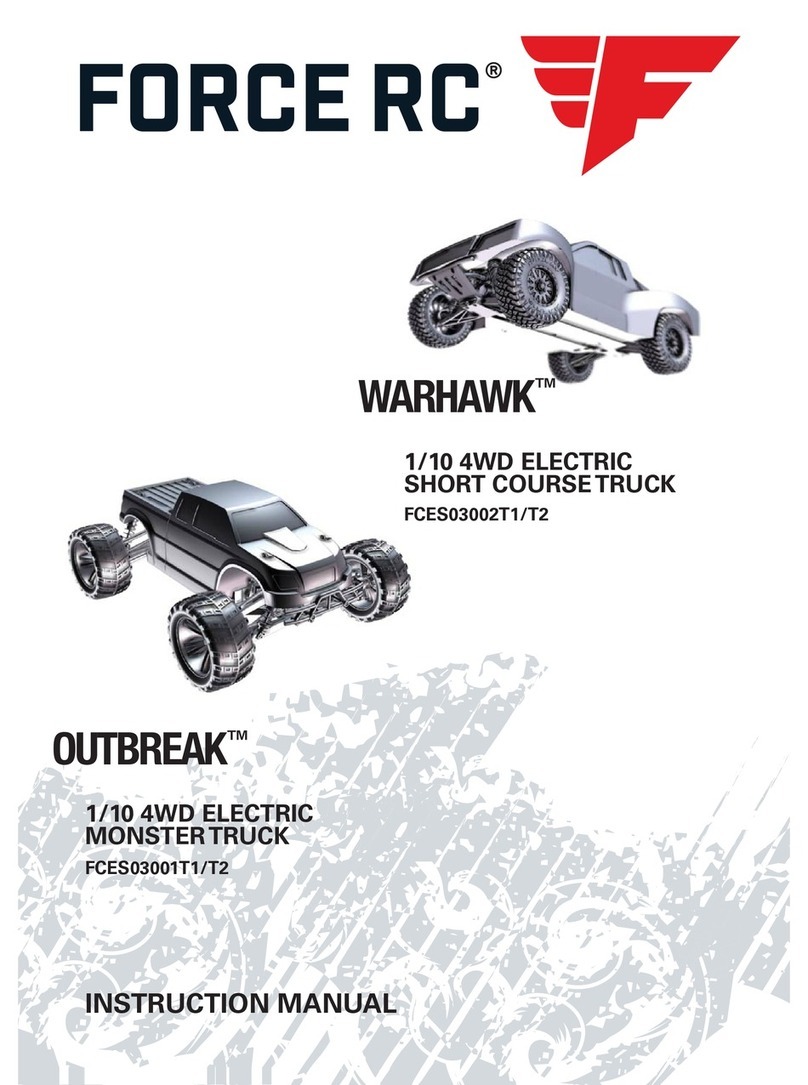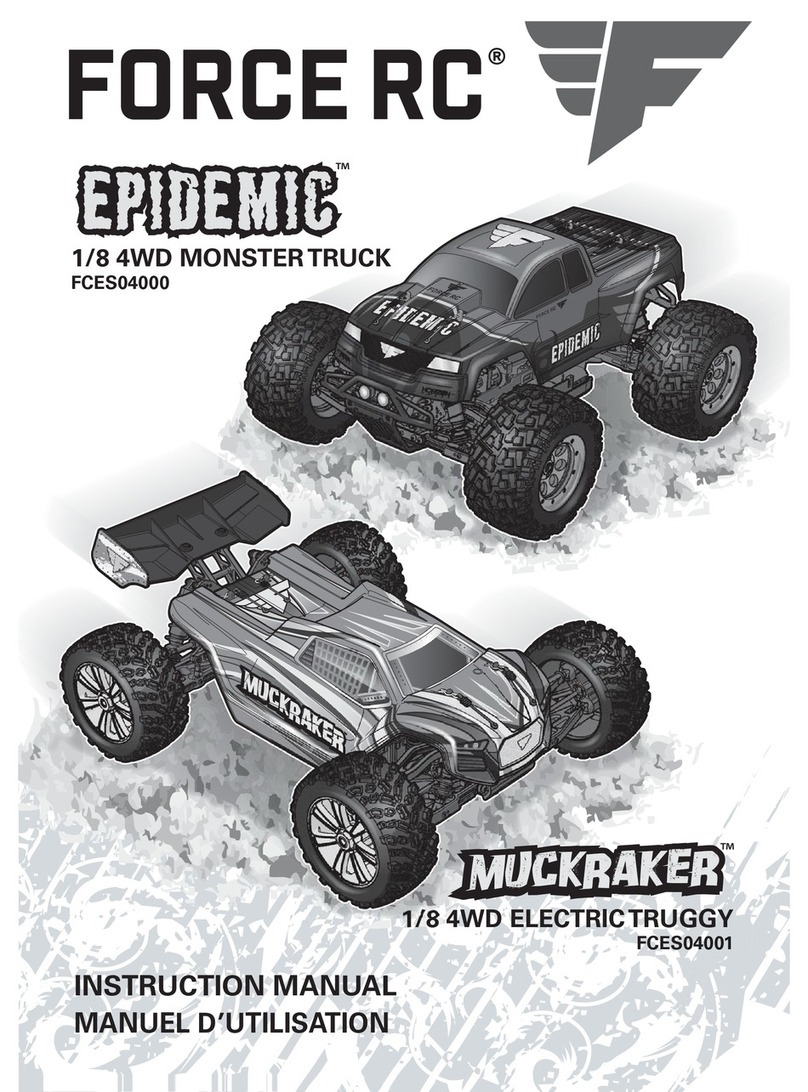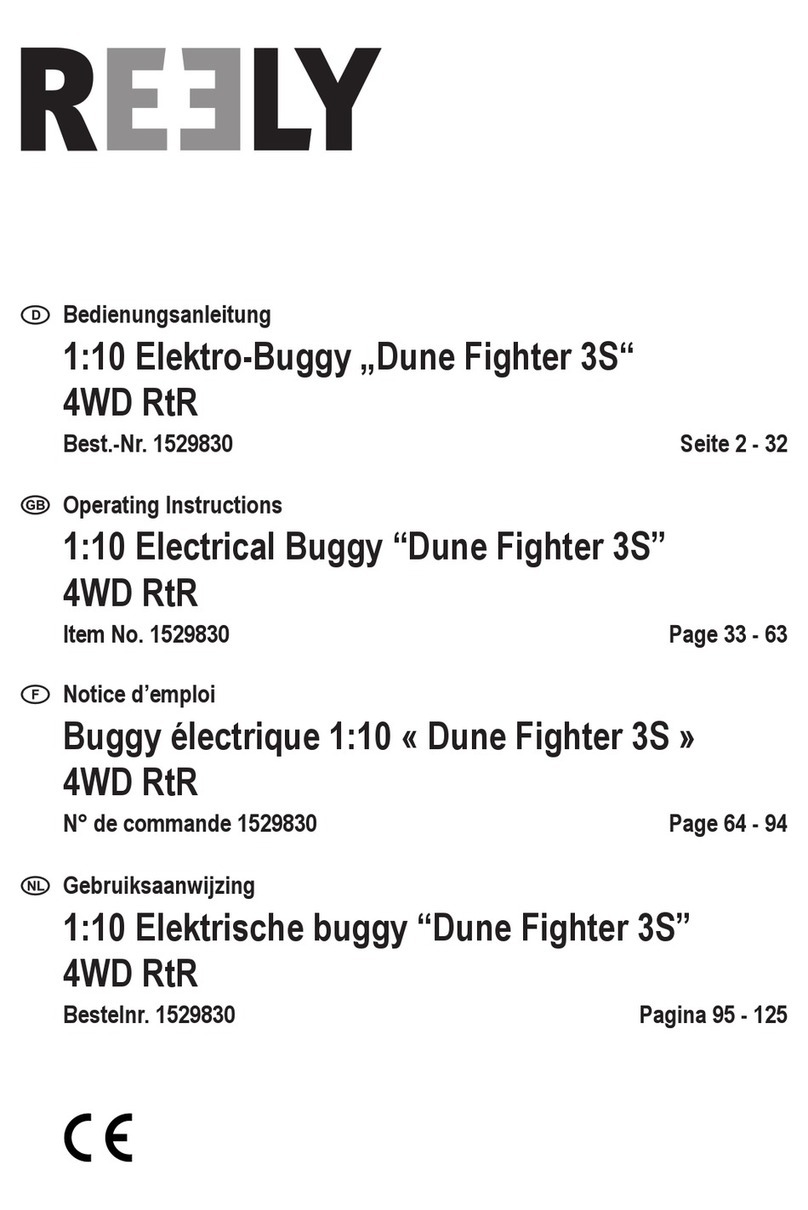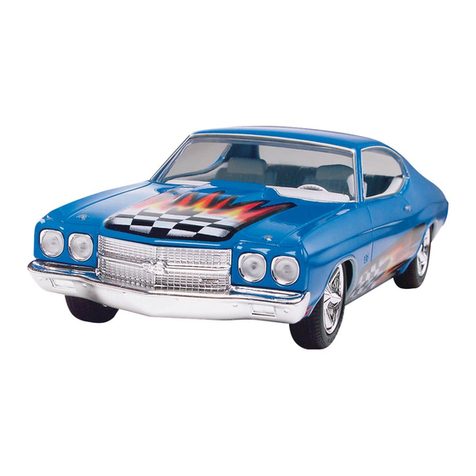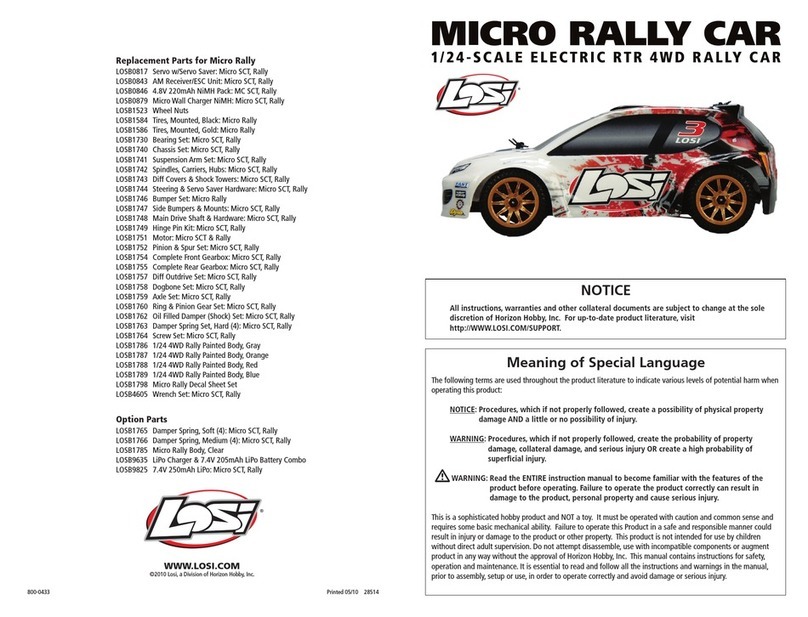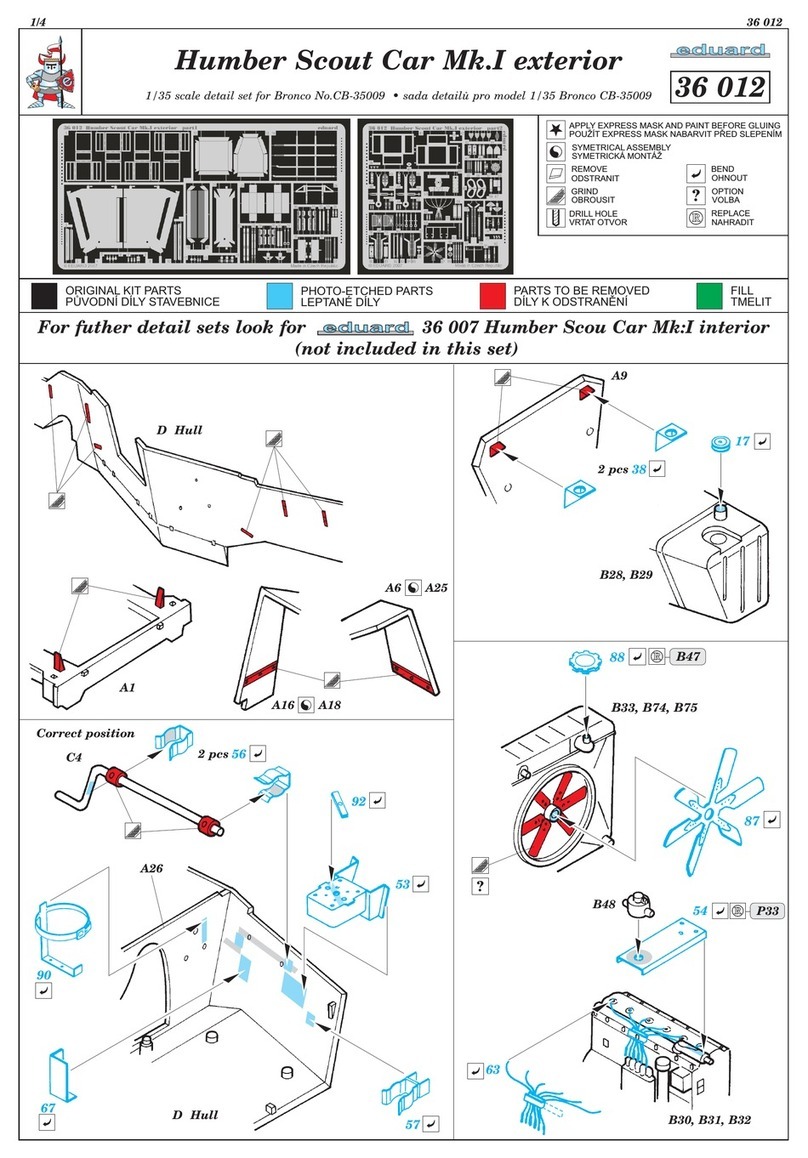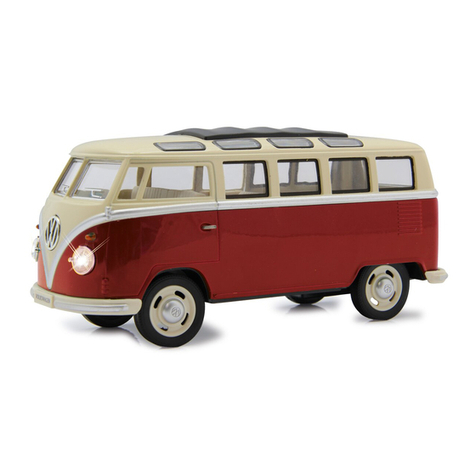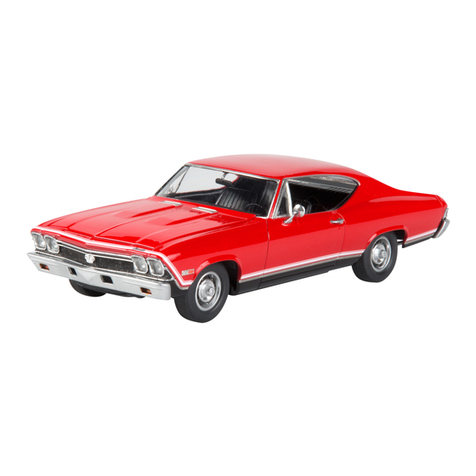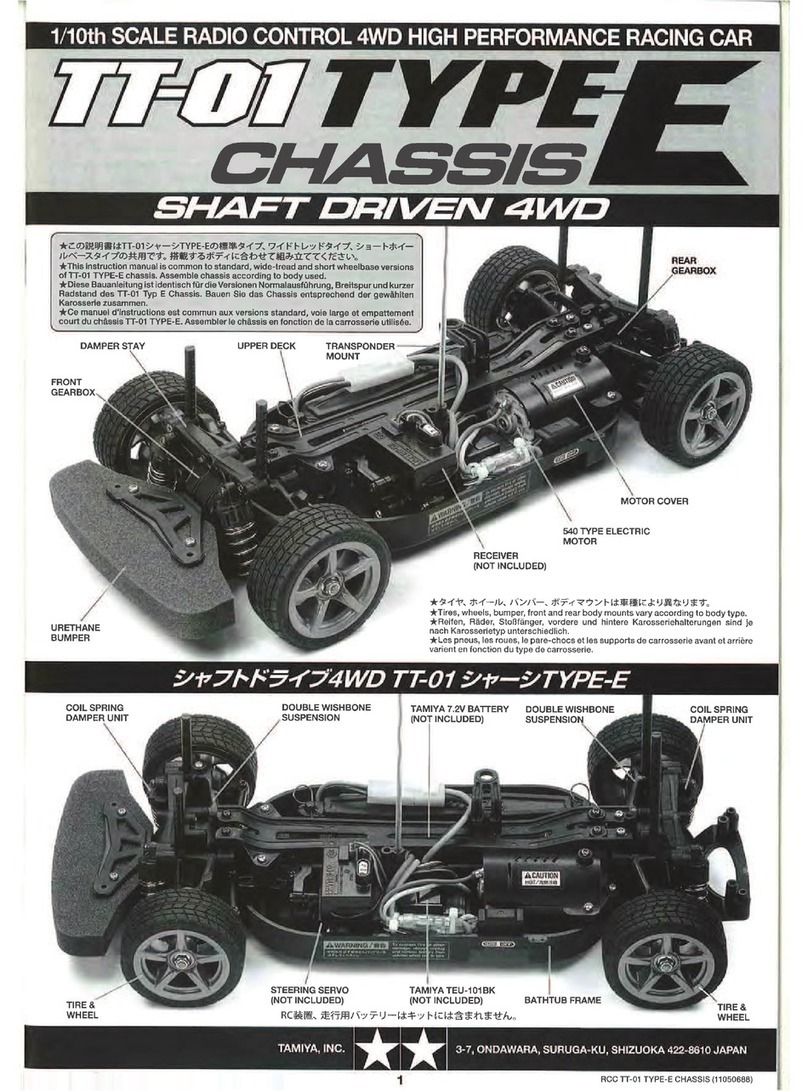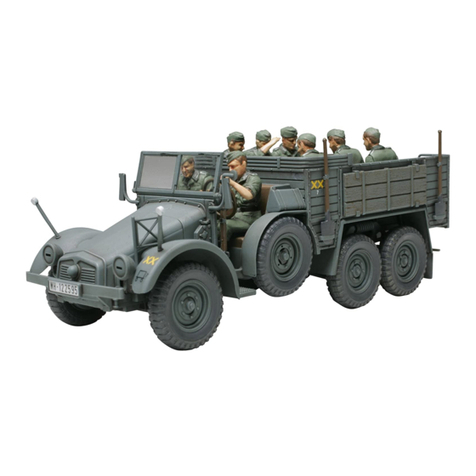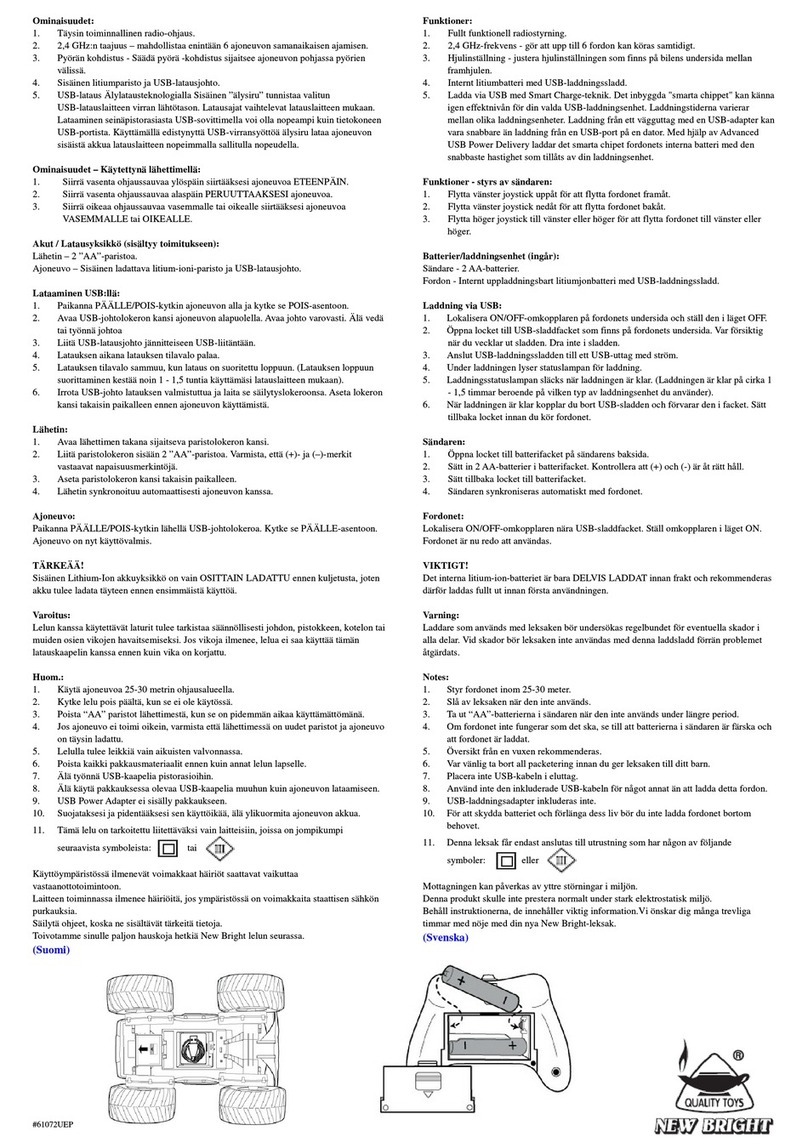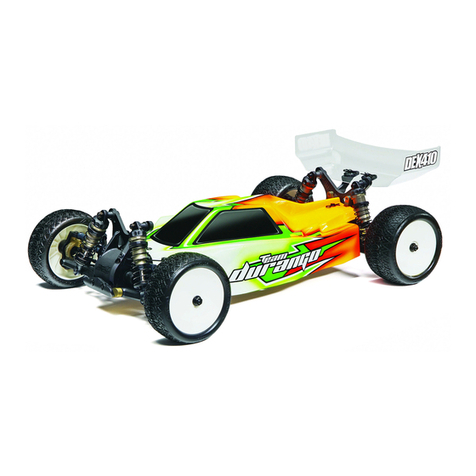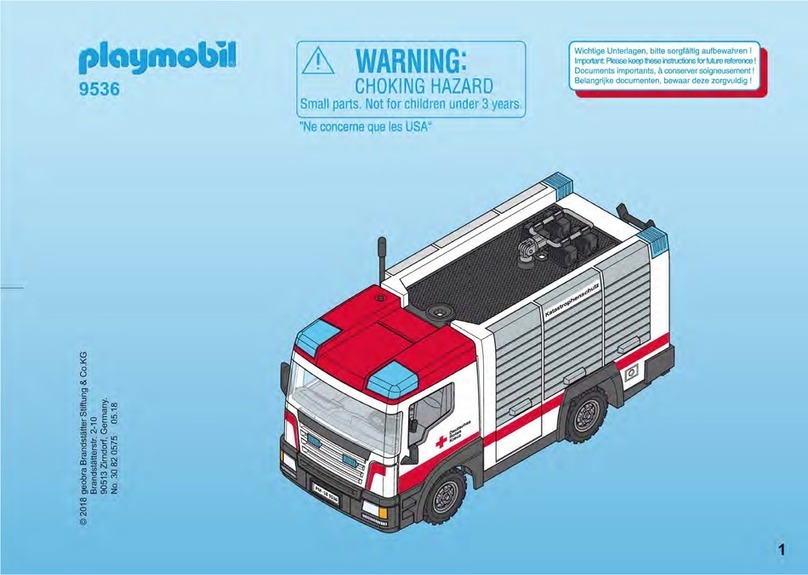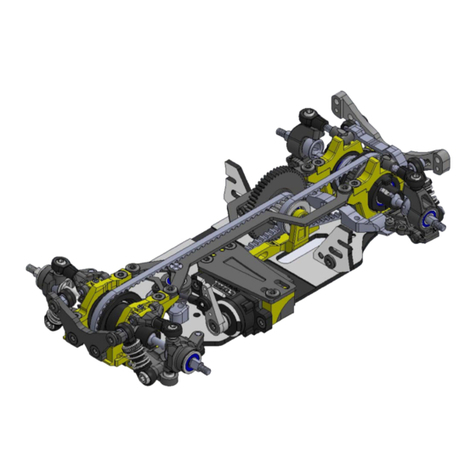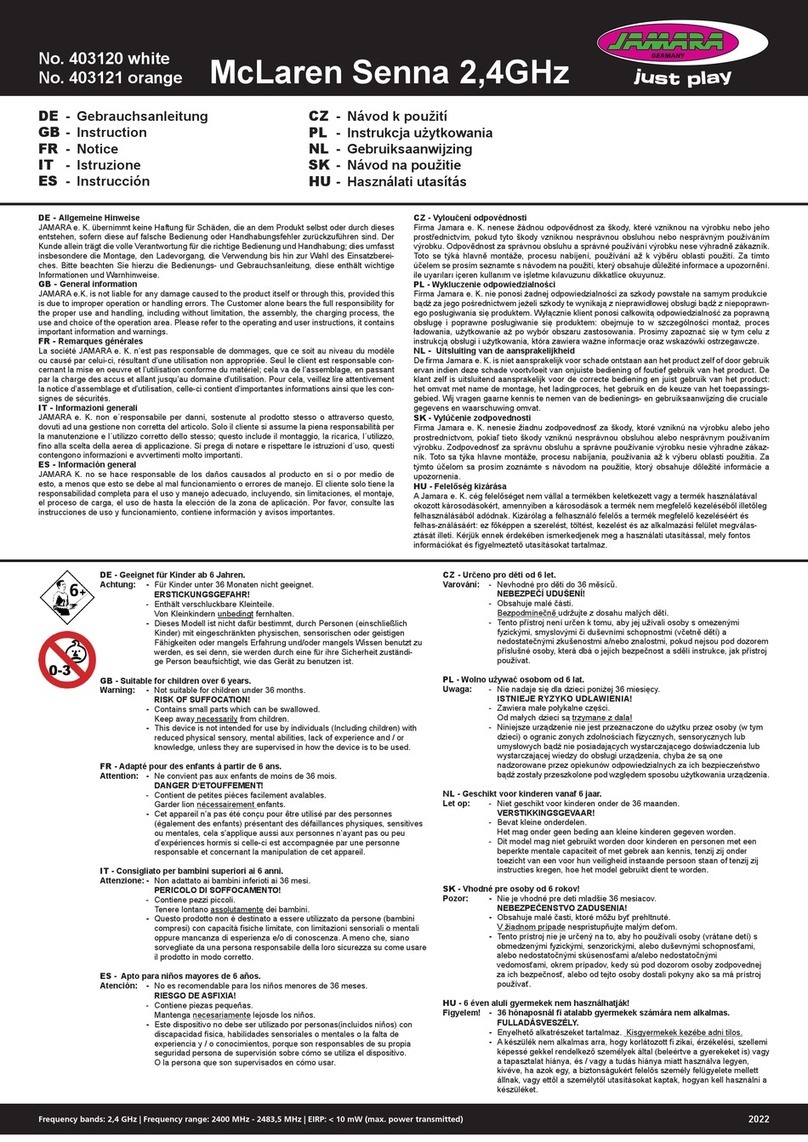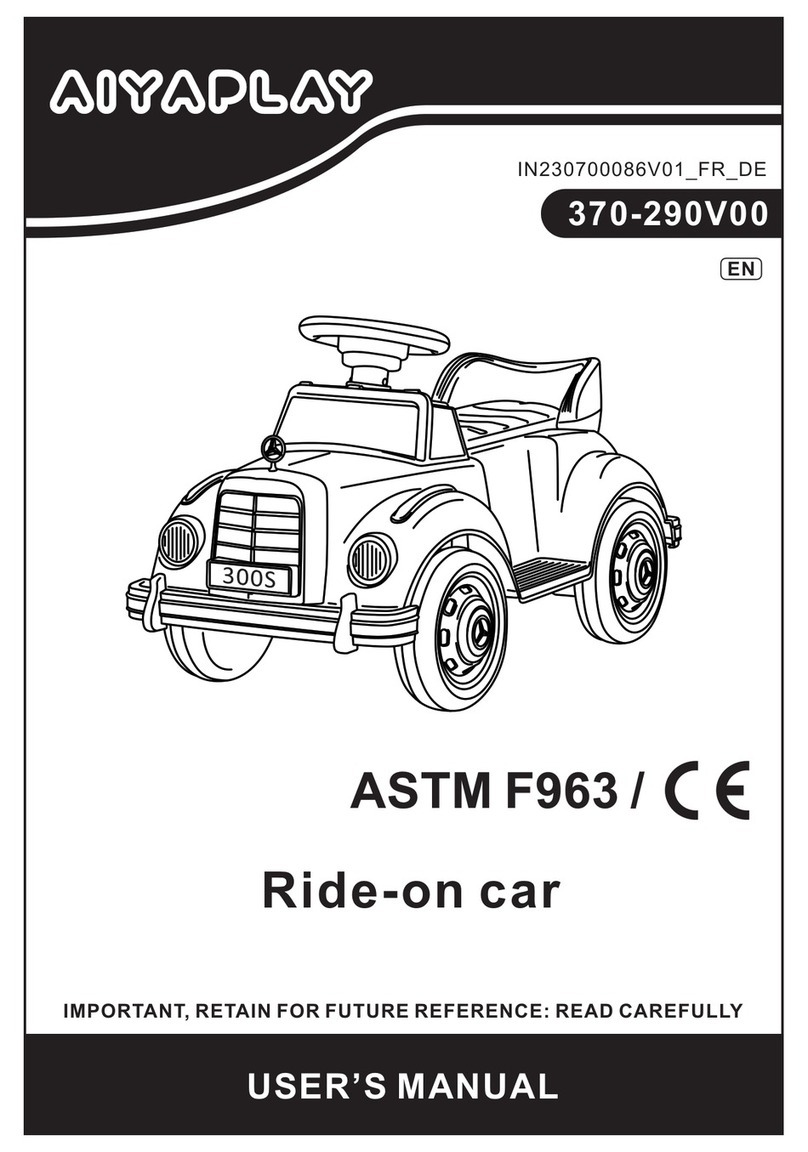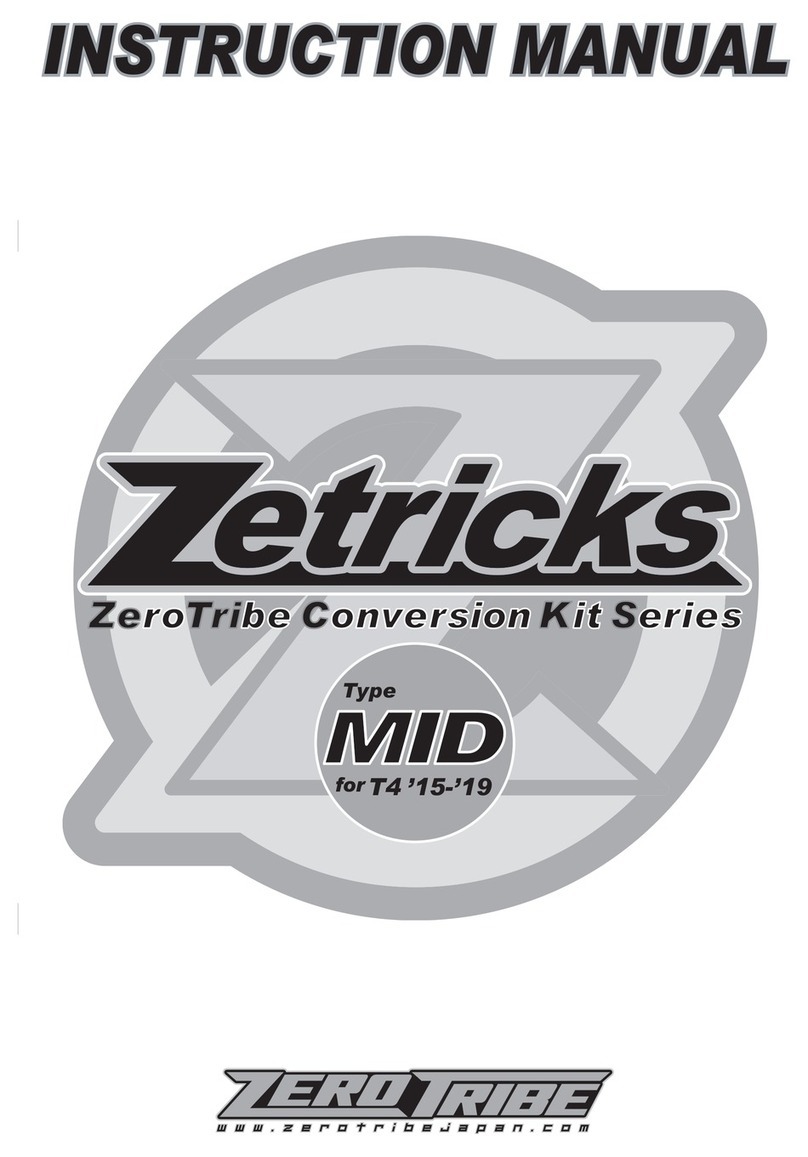Force RC NORTHWOOD FCES03003 User manual

INSTRUCTION MANUAL
MANUEL D’UTILISATION
1/10 4WD SCALER
FCES03003
NORTHWOOD™

2
EN
NORTHWOOD™1/10 4WD SCALER
NOTICE
All instructions, warranties and other collateral documents are subject to change at the sole discretion of Horizon Hobby, LLC.
For up-to-date product literature, visit http://www.horizonhobby.com and click on the support tab for this product.
Safety Precautions and Warnings
As the user of this product, you are solely responsible for operat-
ing in a manner that does not endanger yourself and others or
result in damage to the product or property of others.
This model is controlled by a radio signal subject to interference
from many sources outside your control. This interference can
cause momentary loss of control, so it is advisable to always
keep a safe distance in all directions around your model as this
margin will help avoid collisions or injury.
• Never operate your model with low transmitter batteries.
• Always operate your model in open spaces away from
full-size vehicles, traffic and people.
• Never operate the model in the street or in populated areas
for any reason.
• Carefully follow the directions and warnings for this and any
optional support equipment (chargers, rechargeable battery
packs, etc.) you use.
• Keep all chemicals, small parts and anything electrical
out of the reach of children.
• Never lick or place any portion of the model in your mouth
as it could cause serious injury or even death.
• Exercise caution when using tools and sharp instruments.
• Take care during maintenance as some parts may have
sharp edges.
• Immediately after using your model, do NOT touch equipment
such as the motor, electronic speed control and battery,
because they generate high temperatures. You may burn
yourself seriously touching them.
• Do not put fingers or any objects inside rotating and moving
parts, as this may cause damage or serious injury.
• Always turn on your transmitter before you turn on the
receiver in the car. Always turn off the receiver before turning
your transmitter off.
• Keep the wheels of the model off the ground when checking
the operation of the radio equipment.
WARNING: Read the ENTIRE instruction manual to become familiar with the features of the product before operating.
Failure to operate the product correctly can result in damage to the product, personal property and cause serious injury.
This is a sophisticated hobby product and NOT a toy. It must be operated with caution and common sense and requires some basic
mechanical ability. Failure to operate this Product in a safe and responsible manner could result in injury or damage to the product
or other property. This product is not intended for use by children without direct adult supervision. Do not use with incompatible
components or alter this product in any way outside of the instructions provided by Horizon Hobby, LLC. This manual contains
instructions for safety, operation and maintenance. It is essential to read and follow all the instructions and warnings in the manual,
prior to assembly, setup or use, in order to operate correctly and avoid damage or serious injury.
Meaning of Special Language:
The following terms are used throughout the product literature to indicate various levels of potential harm when operating this product:
WARNING: Procedures, which if not properly followed, create the probability of property damage, collateral damage, and serious
injury OR create a high probability of superficial injury.
CAUTION: Procedures, which if not properly followed, create the probability of physical property damage AND a possibility
of serious injury.
NOTICE: Procedures, which if not properly followed, create a possibility of physical property damage AND little or no possibility of injury.
TABLE OF CONTENTS
Age Recommendation: Not for children under 14 years. This is not a toy.
Water Resistant Vehicle with Waterproof Electronics.............3
Box Contents ............................................................................ 4
Specifications .......................................................................... 4
Vehicle Preparations.............................................................. 4
Charging the Vehicle Battery ....................................................4
CHARGING WARNINGS............................................................4
Installing Transmitter Batteries ................................................ 5
Transmitter Battery Safety Precautions....................................5
Removing and Installing The Vehicle Body...............................5
Installing The Battery In The Vehicle........................................ 5
Transmitter Controls.................................................................. 6
Getting Started..........................................................................7
Motor Care................................................................................ 7
Operation...................................................................................8
When You Are Finished.......................................................... 8
Maintenance ............................................................................ 9
2-in-1 Electronic Speed Control (ESC)/Receiver....................... 9
Electrical Layout........................................................................ 9
Component Specifications..................................................... 10
Binding ......................................................................................10
Failsafe...................................................................................... 10
Shock Cleaning..........................................................................10
Shock Parts Diagram................................................................. 10
Troubleshooting Guide ...........................................................11
Limited Warranty..................................................................... 12
Contact Information.................................................................13
FCC Information........................................................................13
IC Information........................................................................... 13
Replacement Parts .................................................................26
Optional Parts ..........................................................................26
Recommended tools................................................................27
Parts Diagram (Center Chassis)............................................ 27
Parts Diagram (Front and Rear Ends)................................... 28
Parts Diagram (Drivetrain)..................................................... 29
Parts Diagram (Body).............................................................. 29

3
EN
NORTHWOOD™1/10 4WD SCALER
Your new Horizon Hobby vehicle has been designed and built with
a combination of waterproof and water-resistant components
to allow you to operate the product in many “wet conditions”,
including puddles, creeks, wet grass, snow and even rain.
While the entire vehicle is highly water-resistant, it is not
completely waterproof and your vehicle should NOT be treated
like a submarine. The various electronic components used in
the vehicle, such as the Electronic Speed Control (ESC), servo(s)
and receiver are waterproof, however, most of the mechanical
components are water-resistant and should not be submerged.
Metal parts, including the bearings, hinge pins, screws and
nuts, as well as the contacts in the electrical cables, will
be susceptible to corrosion if additional maintenance is not
performed after running in wet conditions. To maximize the long-
term performance of your vehicle and to keep the warranty intact,
the procedures described in the “Wet Conditions Maintenance”
section below must be performed regularly if you choose to run
in wet conditions. If you are not willing to perform the additional
care and maintenance required, then you should not operate the
vehicle in those conditions.
CAUTION: Failure to exercise caution while using this product
and complying with the following precautions could result in
product malfunction and/or void the warranty.
General Precautions
• Read through the wet conditions maintenance procedures and
make sure that you have all the tools you will need to properly
maintain your vehicle.
• Not all batteries can be used in wet conditions. Consult the
battery manufacturer before use. Caution should be taken
when using Li-Po batteries in wet conditions.
• Most transmitters are not water-resistant. Consult your
transmitter’s manual or the manufacturer before operation.
• Never operate your transmitter or vehicle where lightning may
be present.
• Do not operate your vehicle where it could come in contact
with salt water (ocean water or water on salt-covered roads),
contaminated or polluted water. Salt water is very conductive
and highly corrosive, so use caution.
• Even minimal water contact can reduce the life of your motor
if it has not been certified as water-resistant or waterproof. If
the motor becomes excessively wet, apply very light throttle
until the water is mostly removed from the motor. Running a
wet motor at high speeds may rapidly damage the motor.
• Driving in wet conditions can reduce the life of the motor.
The additional resistance of operating in water causes excess
strain. Alter the gear ratio by using a smaller pinion or larger
spur gear. This will increase torque (and motor life) when
running in mud, deeper puddles, or any wet conditions that
will increase the load on the motor for an extended period of
time.
Wet Conditions Maintenance
• Drain any water that has collected in the tires by spinning
them at high speed. With the body removed, place the vehicle
upside down and pull full throttle for a few short bursts until
the water has been removed.
CAUTION: Always keep hands, fingers, tools and any loose or
hanging objects away from rotating parts when performing the
above drying technique.
• Remove the battery pack(s) and dry the contacts. If you have
an air compressor or a can of compressed air, blow out any
water that may be inside the recessed connector housing.
• Remove the tires/wheels from the vehicle and gently rinse
the mud and dirt off with a garden hose. Avoid rinsing the
bearings and transmission.
NOTICE: Never use a pressure washer to clean your vehicle.
• Use an air compressor or a can of compressed air to dry the
vehicle and help remove any water that may have gotten into
small crevices or corners.
• Spray the bearings, drive train, fasteners and other metal parts
with a water-displacing light oil or lubricant. Do not spray the
motor.
• Let the vehicle air dry before you store it. Water (and oil) may
continue to drip for a few hours.
• Increase the frequency of disassembly, inspection and
lubrication of the following:
• Front and rear axle hub assembly bearings.
• All transmission cases, gears and differentials.
• Motor—clean with an aerosol motor cleaner and re-oil the
bushings with lightweight motor oil.
WATER-RESISTANT VEHICLE WITH WATERPROOF ELECTRONICS

4
EN
NORTHWOOD™1/10 4WD SCALER
Frequency 2.4GHz
Run time 10-12 minutes
Included Battery 7.2V, 2000mAh NiMH
Charge Time 10 hours
Compatible Batteries 6 -7 cell NiCad/NiMH and 2 cell LiPo
SPECIFICATIONS
VEHICLE PREPARATIONS
CHARGINGTHEVEHICLE BATTERY
1. Connect the battery pack to the charger.
2. Connect the charger to an AC power source.
3. Allow the battery pack to charge for 10 hours.
CAUTION: If at any time during the charge process the
battery pack(s) becomes hot to the touch, unplug the
battery immediately and discontinue the charge process.
CHARGING WARNINGS
WARNING: Failure to exercise caution while using this
product and comply with the following warnings could
result in product malfunction, electrical issues, excessive heat,
FIRE, and ultimately injury and property damage.
• NEVER LEAVE CHARGING BATTERIES UNATTENDED.
• NEVER CHARGE BATTERIES OVERNIGHT.
• Read all safety precautions and literature prior to use of this
product.
• Never leave the battery and charger unattended during use.
• Never allow children under 14 years of age to charge battery
packs.
• Never attempt to charge dead or damaged batteries.
• Never charge a battery if the cable has been pinched or
shorted.
• Never allow batteries or charger to come into contact with
moisture at any time.
• Never charge batteries in extremely hot or cold places
(recommended between 50–80°F (10–26°C)) or place in direct
sunlight.
• Always use only Ni-MH rechargeable batteries. This charger
cannot charge batteries such as “heavy duty”, “alkaline”,
“mercury” or “lithium” battery.
• Always connect to the charger correctly.
• Always disconnect the battery and charger after charging and
let them cool between charges.
• Always inspect the battery before charging.
• Always terminate all processes and contact Horizon Hobby if
the product malfunctions.
• Always make sure you know the specifications of the
battery to be charged or discharged to ensure it meets the
requirements of this charger.
• Always constantly monitor the temperature of the battery
pack while charging.
• Always end the charging process if the charger or battery
becomes hot to the touch or starts to change form during the
charge process.
• Always charge in a well ventilated area.
The vehicle battery charger produces 200 milliAmps per hour.
Divide the mAh capacity on the label of a battery by 200 to
know how long battery charging will require. For example, a
fully discharged 2000mAh battery requires 10 hours to charge.
BOX CONTENTS
1. Force RC®Northwood™1/10 4WD Scaler (FCES03003)
2. Force RC®Pistol Grip Transmitter (FCES13008)
3. 200mA Battery Charger (DYNC1031)
4. Dynamite®Speedpack®
2000mAh 7.2V Ni-MH battery
(DYNB0020)
5. AA batteries (4)
2
45
31

5
EN
NORTHWOOD™1/10 4WD SCALER
• Never install damaged batteries.
• Never install batteries of mixed types or of different ages in
the transmitter.
• Always remove exhausted batteries.
• Always remove batteries before storing the transmitter.
• Low battery power can result in loss of control of the RC
vehicle.
TRANSMITTER BATTERY SAFETY PRECAUTIONS
REMOVING AND INSTALLING
THE VEHICLE BODY INSTALLINGTHE BATTERY INTHE VEHICLE
1. Install a fully charged battery into battery tray.
2. Secure with hook and loop strap.
3 Connect battery to ESC.
INSTALLINGTRANSMITTER BATTERIES
1. Remove the battery cover from the bottom of the transmitter.
2. Obey the battery plus (+) and minus (-) diagram in the
transmitter to install 4 AA batteries.
3. Install the battery cover.
We recommend using only alkaline AA batteries in the
transmitter.
CAUTION: If using rechargeable batteries, charge only
rechargeable batteries. Charging non-rechargeable
batteries may cause the batteries to burst, resulting in injury to
persons and/or damage to property.
Table of contents
Other Force RC Motorized Toy Car manuals
